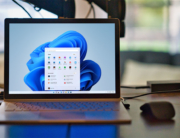Home / Handy Tips /

Recently purchased a new Windows 10 laptop or desktop computer? Performing a proper computer setup is key to ensuring optimised performance.
In this article, we’ll share 10 quick and relatively easy changes to make as you setup your new device. Let’s get right into it.
1. Check for new updates
Microsoft continuously releases software updates, and chances are, new updates have been released since your computer left the manufacturer. While Windows 10 will check for updates automatically, it’s a good idea to check manually before you set up your new device.
To do this, head to Settings by clicking on the gear icon above Start. Select Update & Security, then click ‘Check for updates’.
2. Tweak display settings
If your new computer boasts an incredible 1080p or above display, you may notice text and icons appear much smaller than you’re used to. Don’t be tempted to lower the resolution to combat this problem – this will make images appear a little fuzzy. Instead, tweak the display settings and scale text, icons, and apps.
To do this, right-click on the desktop and select Display Settings. Then, adjust the ‘Change the size of text, apps, and other items’ slider to your liking. You may need to restart your computer for the changes to take effect.
3. Switch on System Restore
Implementing a sound backup system is essential, and the best time to start your backup is right now. Setting up a backup system means that it will be easier if you need computer repairs in the future.
To set a restore point, search ‘restore’. Click ‘Create a restore point’ – this will open the System Properties window. From there, select your main system drive (most likely the C: drive), and hit Configure. You may need to check the ‘Turn off system protection’ if it’s not already checked. Finally, choose how much disk space you’d like to reserve for your restore points. 2-3 percent should suffice.
4. Decide on a touchpad scroll direction
Windows laptops generally scroll in the opposite direction to MacBooks. If you would like to change the scroll direction of your touchpad, head to Settings, then click ‘Devices and Mouse & touchpad’. Swipe the ‘Reverse scrolling direction’ to on.
5. Choose a power performance plan
There’s probably no need for your computer to run at full performance all of the time. Lengthen your battery life and give your eyes a rest by switching to the ‘Power saver’ plan. Or, if you work with demanding graphics, opt for the ‘High performance’ plan. If you want something in the middle, select the ‘Balanced’ plan.
To set a plan, click on the battery icon in the bottom right-hand corner of your desktop. Click ‘Power & sleep settings’. Then, select ‘Additional power settings’ and choose a power plan.
6. Select a default browser
Most Windows users decide not to browse the web on Microsoft Edge, and instead install an alternative browser. If you do this, you’ll want to set your preferred browser as the default.
When opening a new browser for the first time, it will probably prompt you to set it as default. Otherwise, head to Settings > System > Default apps. Click ‘Microsoft Edge’ to make a selection.
7. Disable User Account Control
If you are confident in your own ability to download safe and secure applications from the web, take the time to disable User Account Control. Otherwise, a warning will pop up every time you try to open a newly downloaded app.
To do this, search ‘UAS’ and select ‘Change User Account Control settings’. Switch the slider to ‘Never notify’, click OK, and then Yes.
8. Remove bloatware
New computers are not blank slates. Many PC manufacturers pack their devices with trial apps, taking up valuable hard drive space. The good news is, Windows 10 makes it relatively painless to uninstall and remove ‘bloatware’.
To do this, navigate to Settings. Select System, and then Apps & features. Read through the list. If there is anything you don’t want, simply click the Uninstall button.
9. Show filename extensions
Windows 10 hides filename extensions – the characters at the end of a file name that let you know the file format, such as .jpg or .docx. These are pretty useful, especially when saving the same document or image in a number of formats.
To ensure you can see the filename extensions, open File Explore. Click View from the menu, and check the ‘File name extensions’ box.
10. Tell Cortana to leave you alone
Cortana is really desperate to get to know you. In fact, Microsoft collects your speech and typing history. If this makes you uncomfortable, tell Cortana to back off.
To do this, head to Settings and then Privacy. Click the ‘General’ tab, and swipe off ‘Send Microsoft info about how I write to help us improve typing and writing in the future’. Then, navigate to ‘Speech, inking, & typing’. Then, click ‘Stop getting to know me’.
Want help setting up your new computer?
If you want help configuring key settings, installing new software, and remove frustrating bloatware, get in contact. The expert team at Computer Cures can help with all Windows and Mac computer setups.
We do more than just computer setup though, we can also help you with your office 365 setup and your email setup on your new system. Call today on 1300 553 166 or fill out the form on this page, and we’ll get right back to you.








Leave A Comment